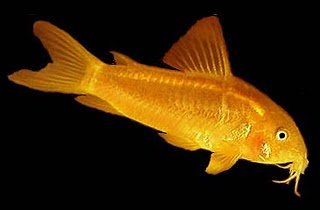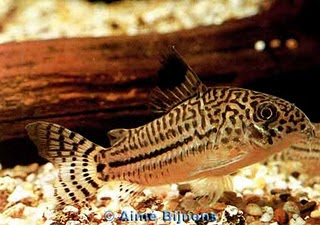1. Introduction Corydoras is one type of ornamental fish freshwater ornamental fish lovers in great demand and have export opportunities. Besides being used as a freshwater fish, also can be used as raw material for cosmetic manufacture in developed countries. Although these fish originated from South America, but since long been successfully cultivated in Indonesia. This fish is known for easy cultivation.
2. Morphological Characteristics
Short and plump body shape, more arched back than the abdomen, both sides are equipped with plates like fish bones arranged in two rows, has two pairs of whiskers located in the upper jaw and lower jaw and body size can reach 12 cm. Corydoras can be cultivated in ponds that contain low oxygen in the water. Environmental conditions suitable for these fish species were: pH 6-8, temperature of 21.5-28 o C.
3. Infrastructure and Facilities In Corydoras necessary maintenance facilities and equipment in the form of materials, namely: a. Corydoras parent female and male
2. Morphological Characteristics
Short and plump body shape, more arched back than the abdomen, both sides are equipped with plates like fish bones arranged in two rows, has two pairs of whiskers located in the upper jaw and lower jaw and body size can reach 12 cm. Corydoras can be cultivated in ponds that contain low oxygen in the water. Environmental conditions suitable for these fish species were: pH 6-8, temperature of 21.5-28 o C.
3. Infrastructure and Facilities In Corydoras necessary maintenance facilities and equipment in the form of materials, namely: a. Corydoras parent female and male
 b. Container maintenance in the form: ~ Bath maintenance male and female master en masse, as well as a place of spawning, or aquarium that measures 60 × 40x40 cm. ~ Bak larval rearing and seed mass c. Feed ~ Feed the parent form or Chironomous tubifex worms and mosquito larvae. Feeding ~ ~ artemia nauplii larvae of food for rearing fish Corydoras until ready for the market is tubifex worms 4. 4.1 Maintenance Operations Parent Corydoras Fish began to be cultivated at least at the age of eight months. Food that is best given in the maintenance of the parent is a lot of feed containing chitin as a good mosquito larvae for egg development. Also because of Corydoras are 'bottom feeders' then the fish is more responsive to the kinds of foods such as tubifex worms or Chironomus. The easiest way to distinguish the sexes is to look at body shape. Male fish have a body shape like terpedo, part of the back of the gills tapering down to the tail. The body is more slender and smaller size than females, and male fish dorsal fins look more pointy. Body of female fish larger than males, and her stomach that looked rounded contain eggs. 4.2. Breeding of mass carried in the bed of cement, fiber tub or aquarium with a ratio of female: male l: 2 or 1:1. Replacement of water every day, to maintain water quality spawning media. Corydoras have the type of spawning with glue their eggs on a substrate that is: plate glass, pieces of paralon (PVC), ceramic tile or stone slabs. Corydoras partially remove her eggs, so every day can be found in the substrate is attached eggs. Each parent can produce 200-350 eggs. Further substrate mounted on the container is taken to be incubated hatching eggs. 4.3. Egg hatching eggs that hatched later attached to the substrate in the aquarium. Eggs will hatch in six days. During the hatching eggs, maintenance media were given anti-fungal drugs such as methylene blue 0.1 ppm. Egg hatching ranged 60-70%. Corydoras larvae reared in the aquarium until the age of seven days with a nauplius feeding artemia. 4.4. Phase Maintenance Maintenance performed on a container vessel in the form of fiber glass or cement to the size S (Small = small) with stocking density 20-30 animals per liter. During one month to reach the size M (Medium = medium) by stocking density 10-15/liter and ready to be marketed.
b. Container maintenance in the form: ~ Bath maintenance male and female master en masse, as well as a place of spawning, or aquarium that measures 60 × 40x40 cm. ~ Bak larval rearing and seed mass c. Feed ~ Feed the parent form or Chironomous tubifex worms and mosquito larvae. Feeding ~ ~ artemia nauplii larvae of food for rearing fish Corydoras until ready for the market is tubifex worms 4. 4.1 Maintenance Operations Parent Corydoras Fish began to be cultivated at least at the age of eight months. Food that is best given in the maintenance of the parent is a lot of feed containing chitin as a good mosquito larvae for egg development. Also because of Corydoras are 'bottom feeders' then the fish is more responsive to the kinds of foods such as tubifex worms or Chironomus. The easiest way to distinguish the sexes is to look at body shape. Male fish have a body shape like terpedo, part of the back of the gills tapering down to the tail. The body is more slender and smaller size than females, and male fish dorsal fins look more pointy. Body of female fish larger than males, and her stomach that looked rounded contain eggs. 4.2. Breeding of mass carried in the bed of cement, fiber tub or aquarium with a ratio of female: male l: 2 or 1:1. Replacement of water every day, to maintain water quality spawning media. Corydoras have the type of spawning with glue their eggs on a substrate that is: plate glass, pieces of paralon (PVC), ceramic tile or stone slabs. Corydoras partially remove her eggs, so every day can be found in the substrate is attached eggs. Each parent can produce 200-350 eggs. Further substrate mounted on the container is taken to be incubated hatching eggs. 4.3. Egg hatching eggs that hatched later attached to the substrate in the aquarium. Eggs will hatch in six days. During the hatching eggs, maintenance media were given anti-fungal drugs such as methylene blue 0.1 ppm. Egg hatching ranged 60-70%. Corydoras larvae reared in the aquarium until the age of seven days with a nauplius feeding artemia. 4.4. Phase Maintenance Maintenance performed on a container vessel in the form of fiber glass or cement to the size S (Small = small) with stocking density 20-30 animals per liter. During one month to reach the size M (Medium = medium) by stocking density 10-15/liter and ready to be marketed. Subsequent maintenance is more directed to the procurement of prospective parent, because usually the size L (Large = large) market demand tends to decline. Density in the maintenance of size M to L size is 5 fish / liter. Feed given during maintenance of the fish until ready to be marketed in the form of tubifex worms. 4.5. Fish Health Management Several types of parasites known to infect Corydoras are: Trichodina sp, Epistylis, Glossatella Chillodonella sp and sp. While the bacteria that attack is usually a secondary infection that occurs due to injuries because of handling, or of parasites that cause injury. Types of bacteria found were Aeromonas hydrophilla. Treatment for parasitic diseases is to use formalin 25 ppm, 500 ppm of salt. As for bacterial diseases using Oxytetracycline 10 ppm by means of immersion.
Subsequent maintenance is more directed to the procurement of prospective parent, because usually the size L (Large = large) market demand tends to decline. Density in the maintenance of size M to L size is 5 fish / liter. Feed given during maintenance of the fish until ready to be marketed in the form of tubifex worms. 4.5. Fish Health Management Several types of parasites known to infect Corydoras are: Trichodina sp, Epistylis, Glossatella Chillodonella sp and sp. While the bacteria that attack is usually a secondary infection that occurs due to injuries because of handling, or of parasites that cause injury. Types of bacteria found were Aeromonas hydrophilla. Treatment for parasitic diseases is to use formalin 25 ppm, 500 ppm of salt. As for bacterial diseases using Oxytetracycline 10 ppm by means of immersion.


No comments:
Post a Comment